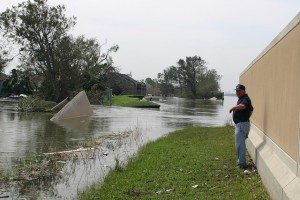Late last summer, civil engineer Matt McBride (Fix the Pumps) brought important information to our attention.
The ever vigilant Mr. McBride had discovered that the Army Corps of Engineers had issued an Engineering Technical Letter (ETL 1110-2-575) stating that the Corps had identified over 50 levee projects nationwide with potential performance concerns.
But the Corps did not reveal the 50 locations. Furthermore, sources to Levees.org indicated the number is actually more than 80 locations.
Believing that residents have a right to know that they may be in danger, Levees.org created a petition demanding that the head of the Army Corps release the locations of the levee systems with performance concerns. We presented the signatures (numbering over 1,100) to Ms. Jo-Ellen Darcy at the Pentagon on February 13, 2013.
Finally, on April 22, 2013, Ms. Darcy responded to our demand to know the whereabouts of the 50-80 locations. Ms. Darcy stated that
“…The Corps has a responsibility to balance the release of critical infrastructure information that will assist the public with making risk-informed decisions with safeguarding information that could be used to do harm. As a result, the Corps does not publish or provide unrestricted access to lists of the location of specific deficiencies for levee systems…”
and that:
“…Residents who would like to know more about levee systems in their communities should contact their local levee sponsor…”
It is not clear to us why a resident in a county protected by levees would contact their local levee sponsor if the resident is unaware that there may be a problem.
“I am not surprised that the Corps will not release the locations of the faulty levees,” says Stradford Goins, civil engineer and former committee member on the Southeast Louisiana Flood Protection Authority East. “They would not and still have not released the input for the assumptions used in their storm surge hydraulic modeling and their design calculations and assumptions for the new levee designs, their so called 100-year level of protection. We were told by many from the Corps and from the SLFPA-E how good this work was. Well in the recent study done by Bob Jacobsen, he points out that there were short-comings fo the modeling and subsequent design.”
For a copy of the letter from Ms. Jo-Ellen Darcy, click here.
To see the original petition, click here.






Leave a Reply